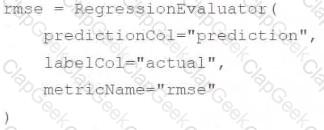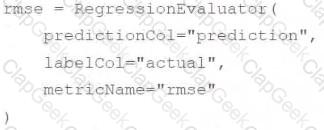A data scientist has defined a Pandas UDF function predict to parallelize the inference process for a single-node model:

They have written the following incomplete code block to use predict to score each record of Spark DataFramespark_df:

Which of the following lines of code can be used to complete the code block to successfully complete the task?
A data scientist is performing hyperparameter tuning using an iterative optimization algorithm. Each evaluation of unique hyperparameter values is being trained on a single compute node. They are performing eight total evaluations across eight total compute nodes. While the accuracy of the model does vary over the eight evaluations, they notice there is no trend of improvement in the accuracy. The data scientist believes this is due to the parallelization of the tuning process.
Which change could the data scientist make to improve their model accuracy over the course of their tuning process?
A data scientist is wanting to explore the Spark DataFrame spark_df. The data scientist wants visual histograms displaying the distribution of numeric features to be included in the exploration.
Which of the following lines of code can the data scientist run to accomplish the task?
A machine learning engineering team has a Job with three successive tasks. Each task runs a single notebook. The team has been alerted that the Job has failed in its latest run.
Which of the following approaches can the team use to identify which task is the cause of the failure?
A data scientist has replaced missing values in their feature set with each respective feature variable’s median value. A colleague suggests that the data scientist is throwing away valuable information by doing this.
Which of the following approaches can they take to include as much information as possible in the feature set?
The implementation of linear regression in Spark ML first attempts to solve the linear regression problem using matrix decomposition, but this method does not scale well to large datasets with a large number of variables.
Which of the following approaches does Spark ML use to distribute the training of a linear regression model for large data?
A machine learning engineer has grown tired of needing to install the MLflow Python library on each of their clusters. They ask a senior machine learning engineer how their notebooks can load the MLflow library without installing it each time. The senior machine learning engineer suggests that they use Databricks Runtime for Machine Learning.
Which of the following approaches describes how the machine learning engineer can begin using Databricks Runtime for Machine Learning?
A data scientist has developed a linear regression model using Spark ML and computed the predictions in a Spark DataFrame preds_df with the following schema:
prediction DOUBLE
actual DOUBLE
Which of the following code blocks can be used to compute the root mean-squared-error of the model according to the data in preds_df and assign it to the rmse variable?
A)

B)

C)

D)

E)

A machine learning engineer is trying to perform batch model inference. They want to get predictions using the linear regression model saved at the pathmodel_urifor the DataFramebatch_df.
batch_dfhas the following schema:
customer_id STRING
The machine learning engineer runs the following code block to perform inference onbatch_dfusing the linear regression model atmodel_uri:

In which situation will the machine learning engineer’s code block perform the desired inference?
A data scientist has developed a machine learning pipeline with a static input data set using Spark ML, but the pipeline is taking too long to process. They increase the number of workers in the cluster to get the pipeline to run more efficiently. They notice that the number of rows in the training set after reconfiguring the cluster is different from the number of rows in the training set prior to reconfiguring the cluster.
Which of the following approaches will guarantee a reproducible training and test set for each model?
A data scientist uses 3-fold cross-validation and the following hyperparameter grid when optimizing model hyperparameters via grid search for a classification problem:
● Hyperparameter 1: [2, 5, 10]
● Hyperparameter 2: [50, 100]
Which of the following represents the number of machine learning models that can be trained in parallel during this process?
An organization is developing a feature repository and is electing to one-hot encode all categorical feature variables. A data scientist suggests that the categorical feature variables should not be one-hot encoded within the feature repository.
Which of the following explanations justifies this suggestion?
A machine learning engineer has created a Feature Table new_table using Feature Store Client fs. When creating the table, they specified a metadata description with key information about the Feature Table. They now want to retrieve that metadata programmatically.
Which of the following lines of code will return the metadata description?
A machine learning engineer is converting a decision tree from sklearn to Spark ML. They notice that they are receiving different results despite all of their data and manually specified hyperparameter values being identical.
Which of the following describes a reason that the single-node sklearn decision tree and the Spark ML decision tree can differ?
A data scientist has been given an incomplete notebook from the data engineering team. The notebook uses a Spark DataFrame spark_df on which the data scientist needs to perform further feature engineering. Unfortunately, the data scientist has not yet learned the PySpark DataFrame API.
Which of the following blocks of code can the data scientist run to be able to use the pandas API on Spark?
Which of the following hyperparameter optimization methods automatically makes informed selections of hyperparameter values based on previous trials for each iterative model evaluation?
A data scientist uses 3-fold cross-validation when optimizing model hyperparameters for a regression problem. The following root-mean-squared-error values are calculated on each of the validation folds:
• 10.0
• 12.0
• 17.0
Which of the following values represents the overall cross-validation root-mean-squared error?
A data scientist learned during their training to always use 5-fold cross-validation in their model development workflow. A colleague suggests that there are cases where a train-validation split could be preferred over k-fold cross-validation when k > 2.
Which of the following describes a potential benefit of using a train-validation split over k-fold cross-validation in this scenario?


